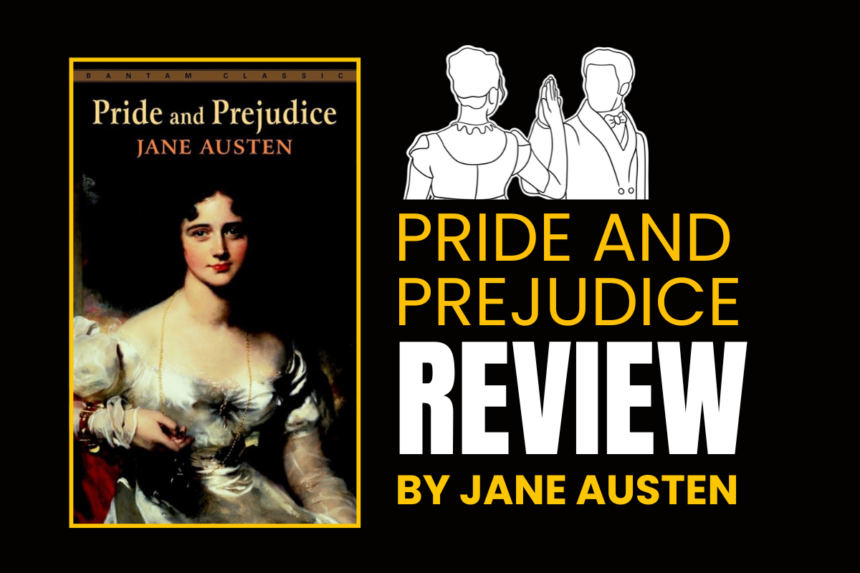Jane Austen’s Pride and Prejudice, first published in 1813, stands as one of the most beloved and enduring works of English literature.
Renowned for its keen observations of 19th-century British society, the novel offers a witty and insightful exploration of love, class, and social expectations.
In this review, we will examine the novel’s themes, characters, and impact, demonstrating why it continues to captivate readers across generations.
Plot Summary
Pride and Prejudice follows the Bennet family, particularly the second eldest daughter, Elizabeth. The story unfolds against the backdrop of the English countryside and explores Elizabeth’s evolving relationship with the wealthy and seemingly aloof Mr. Fitzwilliam Darcy. Initially, Elizabeth’s prejudices against Darcy and his apparent pride create significant tension. However, as the narrative progresses, both characters undergo personal growth and reevaluate their initial judgments, leading to mutual understanding and a deep, genuine affection.
Themes
- Class and Social Mobility: One of the central themes in Pride and Prejudice is the rigid class structure of 19th-century England. The novel scrutinizes the social hierarchy and the impact of class distinctions on relationships and personal ambitions. Elizabeth’s and Darcy’s eventual union challenges societal expectations, suggesting that true merit and character should outweigh social status.
- Marriage and Morality: Austen presents a nuanced view of marriage, exploring it as both a social contract and a personal choice. Through various characters and their relationships, the novel highlights the importance of marrying for love rather than merely for economic security or social advancement. The differing motivations for marriage are illustrated through characters like Charlotte Lucas, whose pragmatic union with Mr. Collins contrasts with Elizabeth’s idealistic vision.
- Pride and Prejudice: The novel’s title refers to the central characters’ initial flaws. Mr. Darcy’s pride and Elizabeth’s prejudice shape their perceptions of one another and their interactions throughout the story. Austen examines how these traits influence their decisions and relationships, ultimately showing how overcoming personal biases is essential for genuine connection and understanding.
- Individual Growth and Self-Realization: Both Elizabeth and Darcy undergo significant personal growth. Elizabeth’s journey involves confronting her own biases and misjudgments, while Darcy learns to temper his pride and embrace humility. Their development highlights the theme of self-improvement and the importance of personal growth in achieving a fulfilling relationship.
Character Analysis
- Elizabeth Bennet: The novel’s protagonist, Elizabeth, is known for her wit, intelligence, and strong sense of morality. Her character challenges societal norms for women of her time and reflects Austen’s own progressive views on gender and individuality. Elizabeth’s evolution from a judgmental and somewhat prejudiced young woman to a more empathetic and self-aware individual is central to the novel’s plot.
- Mr. Fitzwilliam Darcy: Initially perceived as proud and aloof, Mr. Darcy’s character gradually reveals depth and complexity. His transformation from a seemingly arrogant figure to a loving and considerate partner underscores the theme of personal growth. Darcy’s eventual humility and genuine affection for Elizabeth illustrate the novel’s message about the importance of overcoming personal flaws.
- Mr. Charles Bingley: Mr. Bingley, Darcy’s close friend and Elizabeth’s eventual suitor, contrasts with Darcy in his amiable and approachable nature. His role in the story highlights the differences between social expectations and personal happiness, and his relationship with Jane Bennet complements the novel’s exploration of love and compatibility.
- Jane Bennet: Elizabeth’s elder sister, Jane, represents the ideal of sweetness and virtue. Her relationship with Mr. Bingley contrasts with Elizabeth’s dynamic with Darcy, offering a more traditional view of romance and marriage. Jane’s character serves as a foil to Elizabeth, emphasizing different approaches to love and social interaction.
Impact and Legacy
Pride and Prejudice has had a profound and lasting impact on literature and popular culture. Its exploration of social class, romance, and personal growth has inspired countless adaptations, including films, television series, and literary spin-offs. The novel’s sharp social commentary and memorable characters have cemented its place as a classic work of English literature.
Austen’s novel continues to be studied and celebrated for its literary merit, its innovative narrative techniques, and its insightful critique of social norms. Its relevance endures, resonating with contemporary readers and maintaining its status as a quintessential study of human nature and societal expectations.
Conclusion
Jane Austen’s Pride and Prejudice remains a timeless exploration of love, class, and social expectations. Its richly drawn characters, engaging narrative, and keen observations of 19th-century society have ensured its enduring appeal.
The novel’s examination of personal growth, societal constraints, and the nature of true love continues to captivate readers, affirming its place as a beloved classic in English literature.
Austen’s ability to blend sharp social critique with romantic storytelling makes Pride and Prejudice a perennial favorite and a vital part of the literary canon.






